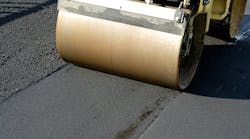Grooming Grove Street
Image: The pavement on Carpenter Street showed signs of failure within the first two years.
Permeable paver parking lots have become more commonplace in the Midwestern U.S. in the past 10 to 15 years. Designers have utilized the same proven pavement sections on a variety of successful projects, while tallying few failures. The village of Downers Grove, Ill., is a progressive community that strives to be on the cutting edge of green infrastructure and storm water management techniques. As such, the village used permeable pavers when reconstructing Grove Street in the heart of its historic downtown.
Permeable pavers maintained the street’s quaint aesthetic while adding some much-needed water quality benefits. By incorporating the permeable pavers with other water quality BMPs, such as bioretention and hydrodynamic separators, the village constructed a successful demonstration project.
Permeable pavers cover Grove Street.
Put to the Test
The project was completed in 2012 and has performed well. The pavers are in good shape, and the village plows Grove Street with a standard steel blade plow. The pavement is swept on the same cycle as the rest of the streets in the downtown area, but the vacuum sweeper is not used to avoid removing any joint filler. There has been some minor settlement around utility structures, for which the village is considering the addition of concrete collars, but the only maintenance necessary to date has been the replenishment of the joint filler aggregate on roughly an annual basis.
A major test of the drainage capacity of the system came within a year of project completion. In April 2013, the village experienced a massive storm event when nearly 7 in. of rain fell on saturated ground in approximately 24 hours. The pavers did their job and the drainage system on Grove Street performed well.
Pavers Under Pressure
While Downers Grove was considering permeable pavers for Grove Street, the village was receiving many complaints of speeding traffic on Carpenter Street.
To resolve this issue, the permeable pavers were extended into a small adjacent portion of Carpenter Street, which carries five times more traffic than Grove Street, as part of a traffic calming measure. In contrast to the pavement on Grove Street, the pavement installed on Carpenter Street showed signs of failure within the first two years. Significant rutting, gaps between pavers and settlement issues had the village staff scratching their heads. The pavement section included more than 18 in. of crushed aggregate over a geotechnical fabric, which handled the higher traffic volumes and speeds on Carpenter Street.
The answer, at least in part, may lie in some recent research and updated guidance. In a study published by the University of California – Davis/Berkeley, testing was performed to validate the relationship between saturation and rutting in permeable interlocking concrete pavement base courses. Due to the high void ratio of permeable base materials and the frequent saturation that is an inherent part of any permeable pavement system, the strength of the pavement cross section can be much lower than with a traditional pavement. In general, for parking lots and low-volume local roads, the depth of the base course required for drainage and storm water storage usually is equipped to handle the light traffic loadings.
On higher volume streets, however, the reduced strength of the base and subbase can have a pronounced effect on the performance of the pavement. The final University of California report presents example design tables that list appropriate base and subbase thicknesses to accommodate various traffic loadings, inundation frequencies and subgrade soil types. This research is enormously helpful for the successful design of permeable paver streets, and already is being referenced in available, actionable guidelines, such as the Caltrans Pervious Pavement Design Guidance.
The village reached out to material suppliers and contractors, and was able to rehabilitate Carpenter Street at no cost.
Thinking Outside the Box
This new research and guidance will be useful for the design of future permeable streets, but the village of Downers Grove was still left with a predicament.
Removing all of the pavers, base and subbase materials, and then excavating deeper in order to install the recommended subbase depths, would have been cost prohibitive. The inclination at that time was to remove the permeable pavers on Carpenter Street and replace them with asphalt.
One last option was available, and although it was not a guaranteed solution, it did show significant promise. The use of triaxial geogrids as inter-layers between the subbase and base course of traditional pavements recently has been utilized with success.
The geogrid acts as a support for the base course above it, and can generate a much higher structural number without the need to increase the depth of the subbase. The village was encouraged by the prospect of utilizing a triaxial geogrid to repair and strengthen the pavement on Carpenter Street, but did not wish to spend additional tax dollars on a solution that was untested and may not completely solve the problem. As such, the project team reached out to material suppliers and contractors to ask for help with this project. Through donations of the geogrid, new pavers, new base course aggregate and two contractors to perform the work, the pavement on Carpenter Street was reconstructed with a higher structural number than before at no cost to the village.
The pavement will be monitored to see if the geogrid has strengthened it enough to withstand the traffic on Carpenter Street. Only time will tell if this project is a success, but it could open the door to the utilization of permeable pavers in roadway applications that previously would have been economically infeasible.
Triaxial geogrids were installed above the subbase, acting as a support for the base course.


